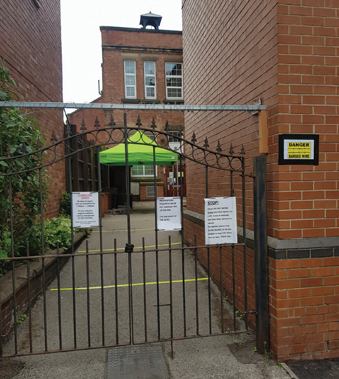For the July 2020 print edition of Professional Security magazine, we intend to digest the changes forced on the British way of life as a result of response to the Covid-19 pandemic. We’ve first looked at what social distancing could mean in terms of urban geography, whether adding to trends for car-free zones, and creating stand-off between buildings and pedestrians and cars, to mitigate the risk of ‘vehicle as a weapon’. In London for example the Mayor Sajid Khan has urged ‘we will need many more Londoners to walk and cycle to make this work’, having said that public transport should be used only as a last resort and the Congestion Charge were reinstated on May 18 and will increase to £15 next month.
Assuming that shoppers and office workers have made it to the city or town centre safely, then what?! Might there be new lay-outs at and inside buildings? For safer flow, instead of deliveries coming into basements or receptions, might incoming goods (whether parcels, mail or items bought by staff who cannot be at home to take delivery) have to be left outside? If so, will such arrangements be temporary for the summer, or for good?
The picture tells a story, of how response to social distancing still has to bear crime prevention in mind. The GP surgery in Stapenhill, Burton upon Trent, Staffordshire is a former Victorian infants school. Entry is either through what is now the car park at the back, or the front (pictured) from the street as in its days as a school. Prescriptions were normally taken into the surgery and popped inside a box on the wall past the front door. For lockdown, patients are asked instead to put the forms into a letterbox from the street (to the right of camera).
The gazebo offers cover for those waiting to enter the surgery; as elsewhere, patients are asked not to attend in person unless they have an appointment. An original gazebo was stolen. The gazebo pictured is a replacement; also new is the barbed wire around a metal bar fixed above the gate.
For schools as for surgeries and shops, museums, hotels and pubs, building managers have to work out how to resume business while offering hand-washing or hand sanitation, and abiding by social distancing according to UK Government guidance; whether limiting the number of access and exit doors (already done commonly to limit the escape routes for shoplifters and opportunistic thieves) or through way-finding or markings on floors, to apply one-way walking in corridors.
Significantly, the guidance acknowledges that Covid-19 is not the only consideration. For example, while you may (in a mall or market, or outdoors on a high street or park) seek to ‘reduce unnecessary obstacles, for example planters’ and add markings or tape on seating to maintain social distancing, ‘security considerations and the impacts of measures on people with disabilities and other groups needs to be kept under consideration and may call for a balanced approach’. If a shop or mall is defining ‘areas to indicate where pedestrians should stand when queuing’, that may imply a call for ‘marshals’ or general staff to keep the rule or be on hand to give directions of offer advice.
As the guidance points out, every urban centre will have its own unique issues, such as footfall; though themes are common, such as traffic management, and managing flow of people. If entry and exit points are restricted and cause queues, that may create a terrorism security risk of a ‘crowded place‘. Physical security, protection of assets, still applies, as according to the official CPNI. Planters, to return to them, may be there outside a stadium or jeweller or shopping centre to deter a ram-raid.
A £50m ‘Reopening High Streets Safely Fund‘ has been launched by the Ministry of Housing, Communities & Local Government for councils in England.










